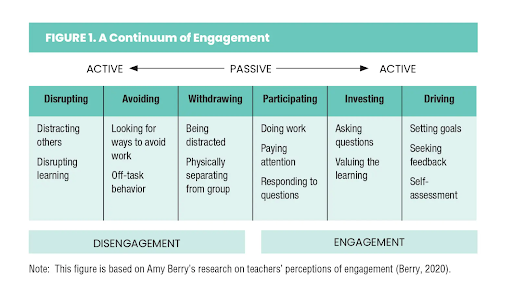Developing a Culture of Engagement
- August 28, 2023
- By Mandi Olson

The beginning of the school year provides an opportunity for students to develop the skills needed to understand their role in learning and how the choices they make as learners help them to engage in their work. While it is imperative for teachers to provide learning opportunities for students to foster engagement, teaching students about their role in learning and levels of engagement will help them to recognize the role they play in the learning process.
Often engagement is viewed by educators as what students are doing in a classroom. Do students complete tasks, activities, or assignments? Viewing engagement as a student’s willingness to be challenged in their learning allows educators to support students in being willing to try harder tasks and be open to failure in learning. Failure should be viewed by students as part of learning and they should be willing to engage in challenging tasks and making mistakes.
Researcher, John Hattie, examined and synthesized more than 1,000 meta-analyses which comprised more than 50,000 individual studies, to determine factors that affect student learning and achievement. In his book, Visible Learning, Hattie ranked 138 effects that influence learning outcomes and he continues to add to his research as his original list has grown to 195 (Hattie, 2017). This research is helpful to educators because if almost any change in education will have a positive effect, why not focus on those that will have the greatest effect on student learning? A year’s growth, calculated by Hattie, is 0.40. So from his rankings of 195 effects on learning, educators can examine those influences that have a greater chance of increasing student learning and begin to use them in their teaching practice.
Hattie, explains that often teachers view the criteria for successful learning as the same as the criteria for successful classroom management (Hattie, 2023). In this way, performance becomes a function of student interest, motivation, and an understanding of the purpose of the teacher’s activities. An alternative model is proposed by Berry (2023) and can be used by teachers to help students understand their role in the learning process. This six-factor model of engagement includes: disrupting, avoiding, withdrawing, participating, investing, and driving. According to the model, the aim is to move students’ engagement from participating to driving so that they are more aware of the various types of disengagement. Teachers can use this model with students so that they understand what disengagement and engagement look like and how they make choices to become more engaged in their learning. Berry’s Continuum of Engagement can help students see the actions they can take to become engaged in learning as well as providing examples of actions that show disengagement. This model provides a unique framework for teachers to help students see what they can do to become active participants in their learning.

As educators take the time to understand the various components of engagement, they will be more able to teach these skills to students. As students understand their role in the learning process they can become more engaged learners. Models, such as the one provided by Berry (2023) can help teachers understand more about engagement and when they teach these skills to students, engagement will increase. As an educator, when I have taught students the different skills of engagement they are more likely to understand their role in the learning process and can begin to self-regulate to increase their likelihood of success in school.
References:
Berry, A. (2023). Reimagining student engagement: From disrupting to driving. Corwin.
Hattie, J. (2017, May). How to Empower Student Learning with Teacher Clarity. Corwin. Retrieved November 15, 2021, from https://us.corwin.com/sites/default/files/corwin_whitepaper_teacherclarity_may2017_final.pdf.
Hatti, J. (2023). Visible Learning: The Sequel. Corwin